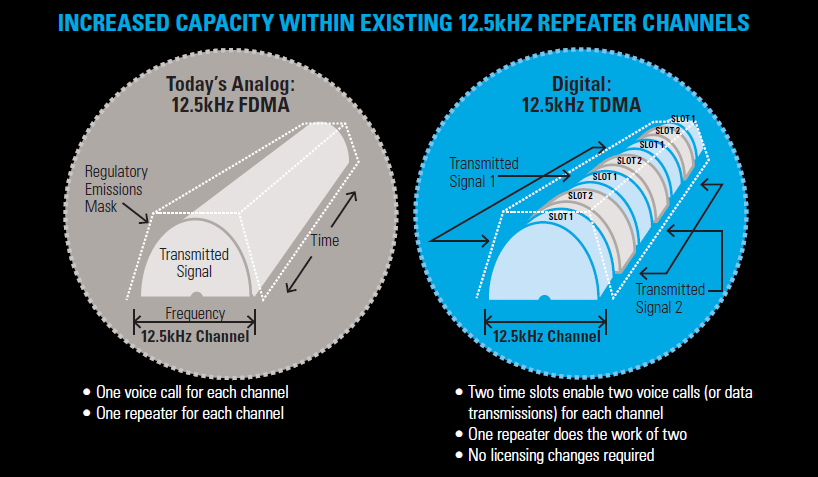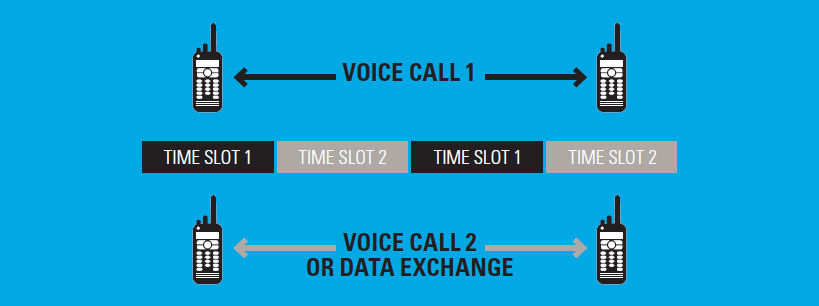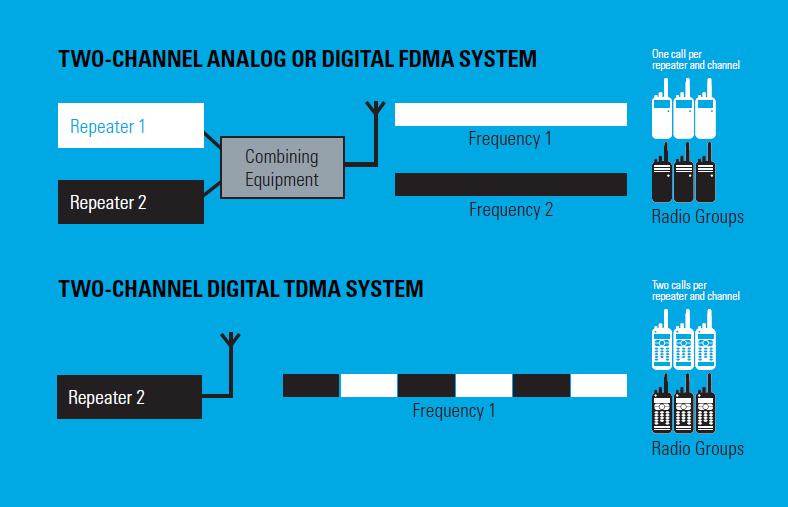What is TDMA and How Does It Work?
11 Aug. 2016 Information
TDMA stands for “Time-Division Multiple Access.” Like FDMA, or “Frequency-Division Multiple Access,” TDMA is a technology that allows multiple conversations to share the same radio channel. Although the goal is the same, the two technologies work very differently.
6.25 kHz FDMA
In FDMA, a channel frequency is split into smaller subdivisions — for example, splitting a 25 kHz band into two narrower “sub-channels” that transmit side-by-side to achieve 12.5 kHz equivalent spectral efficiency. The same technique can be used to achieve 6.25 kHz equivalent efficiency in a 12.5 kHz channel — although how well this technique will perform hasn’t yet been established in real world implementations on a large scale. As the subdivisions of a licensed channel become narrower, there’s a growing likelihood of problems due to congestion and interference in an FDMA-based 6.25 kHz-equivalent system, as shown in the illustration. When you try to squeeze two 6.25 kHz signals into one 12.5 kHz channel, you still have to meet the channel’s regulatory emissions mask. In order to do so, the signal deviation (represented by the height and width of the lobes in the illustration) must necessarily be smaller than what can be achieved with a single 12.5 kHz signal. This smaller deviation means reduced sensitivity, which in turn reduces effective signal range in real world conditions. At the same time, there is very little tolerance for errors introduced by oscillator aging, and the 6.25 kHz signal contains more energy near the edges of the mask — making it more prone to adjacent channel interference and near/far interference problems. This results in reduced quality of service in real world conditions.
Two-slot TDMA
By comparison, TDMA offers a proven method for achieving 6.25 kHz equivalency in 12.5 kHz repeater channels — a major benefit for users of increasingly crowded licensed bands. Instead of dividing the channel into two smaller slices, TDMA uses the full channel width, dividing it into two alternating time slots. As a result, TDMA essentially doubles repeater capacity while preserving the well-known RF performance characteristics of the 12.5 kHz signal. From the perspective of RF physics — that is, actual transmitted power and radiated emissions — the 12.5 kHz signal of two-slot TDMA occupies the channel, propagates, and performs essentially the same as today’s 12.5 kHz analog signals. With the added advantages of digital technology, TDMA-based radios can work within a single repeater channel to provide roughly twice the capacity of analog while offering RF performance equivalent to, or better than, today’s
analog radio.
As we will see, the two time slots can potentially be used for a variety of purposes. Most organizations considering TDMA based two-way radio will probably be interested in doubling the voice capacity per licensed repeater channel. By enabling 6.25 kHz equivalency, TDMA supports two simultaneous, independent half-duplex calls in a single 12.5 kHz repeater channel.
If you’re used to thinking about analog radio, this two-for-one capacity in two different time slots might seem problematic. Wouldn’t the two calls cut in and out as the time slots alternate, making both conversations nearly impossible to understand?
But remember, this is the digital world, where voices are encoded in bits. Although analog signals represent the actual duration of spoken words, digital signals can encode that duration in a way that allows for significant compression without compromising voice quality. Each TDMA time slot is quite brief — on the order of 30 milliseconds. The circuitry that translates voice into bits is actually able to pack 60 milliseconds worth of digitized speech into each 30 millisecond time slot. The receiver, in turn, unpacks those bits into speech that has its full 60 millisecond time value. That’s why, with TDMA, two conversations can happen simultaneously and seamlessly via a single repeater. The alternation of time slots is something that happens in the technology only, not in the user’s experience. In fact, digital technology offers better background noise suppression than analog while preserving the integrity of the signal at the farthest reaches of the transmitter’s range — so both digital conversations are likely to be much clearer than a single analog conversation would be over the same channel. And because both conversations use the channel’s full bandwidth, there’s no degradation in range performance, and no added risk of interference with adjacent channels.
Advantages of Two-Slot TDMA for Professional Organizations
Increased Spectral Efficiency
As we have discussed, two-slot TDMA offers a proven way to enable 6.25 kHz equivalent efficiency in licensed 12.5 kHz repeater channels. This doubles per-channel communications capacity, while satisfying future regulatory requirements for 6.25 kHz equivalent efficiency. And unlike 6.25 kHz transmission methods built on FDMA technology, TDMA fits seamlessly into existing licensed channel structures in UHF and VHF — known performance, no need for rebanding or relicensing, and no risk of new forms of radio channel interference. The choice of TDMA digital technology makes it quick and easy to gain spectrum efficiency and improve your two-way radio communications.
Lower Equipment Costs
Compared to 6.25 kHz FDMA, two-slot TDMA allows you to achieve 6.25 kHz equivalent efficiency while minimizing investments in repeaters and combining equipment. This is one reason why TDMA is so well suited to professional applications, where the budget for two-way digital radio may be limited compared to the mission-critical tier. FDMA requires a dedicated repeater for each channel, plus expensive combining equipment to enable multiple frequencies to share a single base-station antenna. It can be particularly expensive to make combining equipment work with 6.25 kHz signals, and there’s typically a loss in signal quality and range when it’s used this way. In contrast, two-slot TDMA achieves two-channel equivalency using single-channel equipment. No extra repeaters or combining equipment is required.
Advanced Features and Flexibility
In a traditional FDMA two-way radio implementation, each transmission occupies a full 12.5 kHz channel. A single channel can accommodate a single, half-duplex call. Proprietary implementations that use FDMA to achieve two 6.25 kHz equivalent channels enable two conversations to take place within a 12.5 kHz channel — but again, both of these conversations are half-duplex, and there’s no flexibility to put the extra capacity to any other use. TDMA-based;digital systems with two time slots aren’t bound by these technical restrictions. The two time slots can be used to carry two half-duplex conversations — as with the two sub-channels in an FDMA-based system — but with no need for extra equipment and no danger of reduced performance. Unlike FDMA, however, it’s also possible to use the second TDMA time slot for other purposes. For example, device designs for the first-generation of TDMA-based two-way radio include the ability to use the second time slot for reverse-channel signaling. This capability;can be used for priority call control, remote control of the transmitting radio, emergency call pre-emption, and more. The second time-slot could also be used for transmitting application data such as text messaging or location data in parallel with call activity — a useful capability, for example, in dispatch systems that provide both verbal and visual dispatch instructions.
TDMA-based systems also offer the flexibility to adapt as new applications emerge to make additional use of the two time slots — preserving initial investments while providing an open path to future usage models for digital two-way radio. For example, the future roadmap for two-slot TDMA applications includes the ability to temporarily combine slots for increased data rates, or to use both slots together to enable full-duplex private calls. Additional capabilities will also emerge, as driven by the real-world needs of two-way radio users in the professional marketplace. By choosing TDMA, professionals can immediately gain benefits such as 2:1 voice capacity and reverse-channel signaling within a single channel, with the option to add other capabilities as they become available. FDMA, in contrast, is optimized for a single purpose — half duplex calling.
Longer Battery Life
One of the biggest challenges with mobile devices has always been battery life. In the past, there have only been a couple of options for increasing the talk time on a single battery charge. One way is to increase battery capacity. Battery manufacturers have already done a remarkable job of maximizing capacity, but further gains are only possible by increasing the size of the battery pack and therefore decreasing portability.
The other option is to decrease transmit power, which is by far the most energy-intensive function of two-way radio. But this means decreasing transmission range and increasing the potential for interference from other devices — an unacceptable trade off in professional situations. Two-slot TDMA provides another, very effective option. Since each call uses only one of the two slots, it requires only half of the transmitter’s capacity. The transmitter is idle half the time — that is, whenever it’s the unused time-slot’s “turn.” For example, in a typical duty cycle of 5 percent transmit, 5 percent receive, and 90 percent idle, the transmit time accounts for roughly 80 percent of the total current drain on the radio’s battery. By cutting the effective transmit time in half, two-slot TDMA can thus enable an up to 40 percent reduction in current battery drain, or an up to 40 percent improvement in talk time. As a result, overall battery consumption per call is dramatically reduced, enabling much longer usage time in the field between recharges. Modern digital devices also include sleep and power-management technologies that increase battery life even further.
(Source:
Why Digital White Paper)


